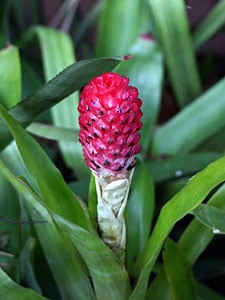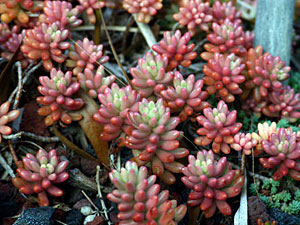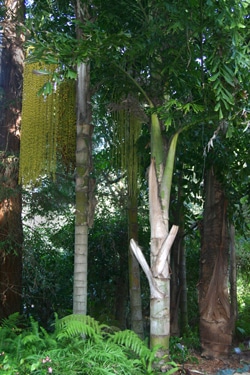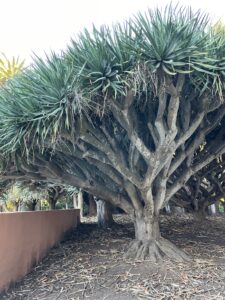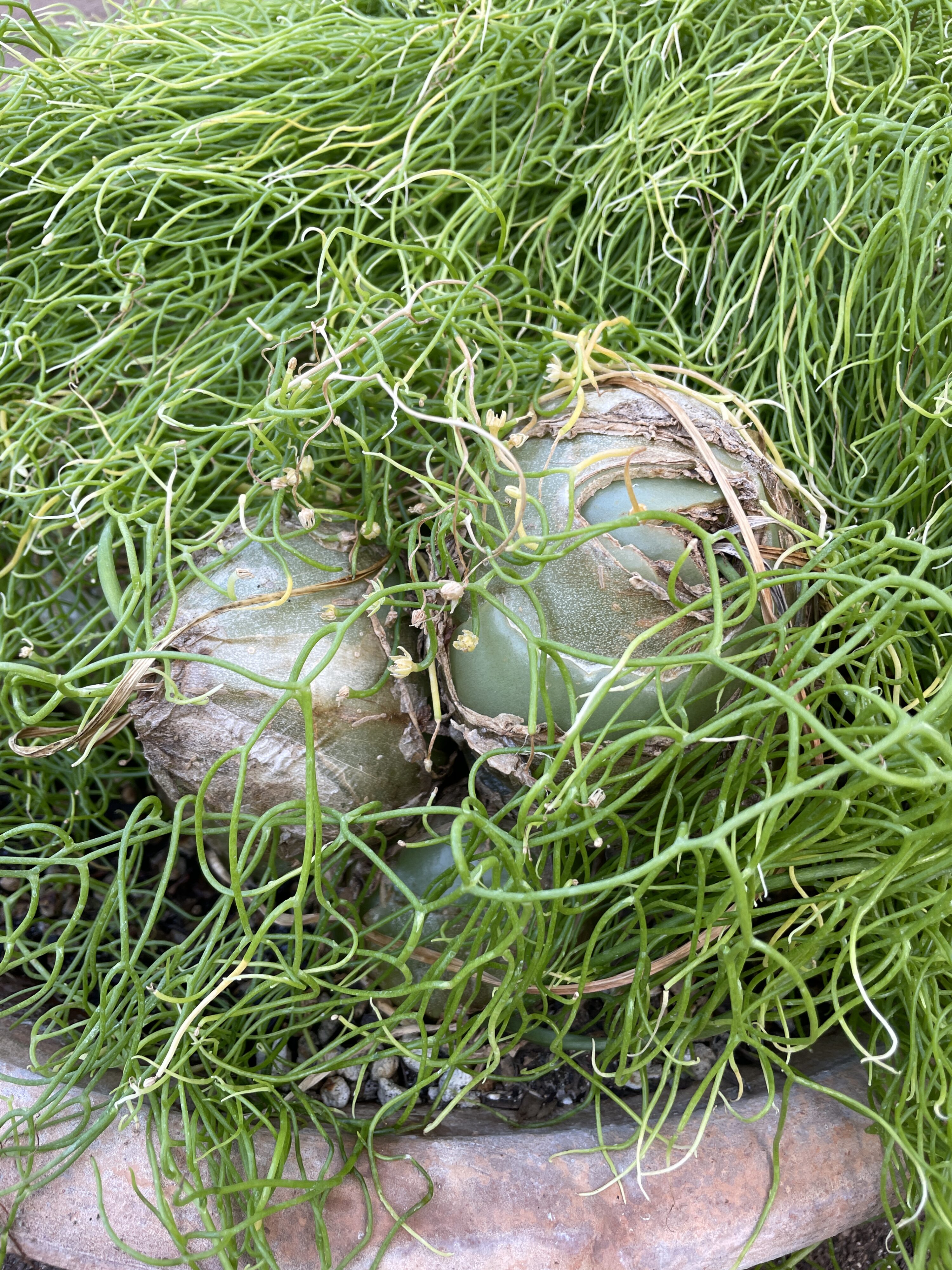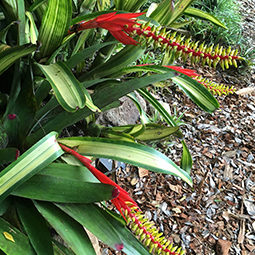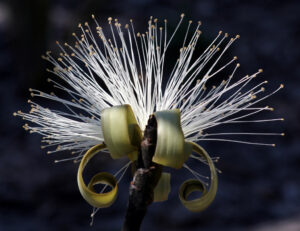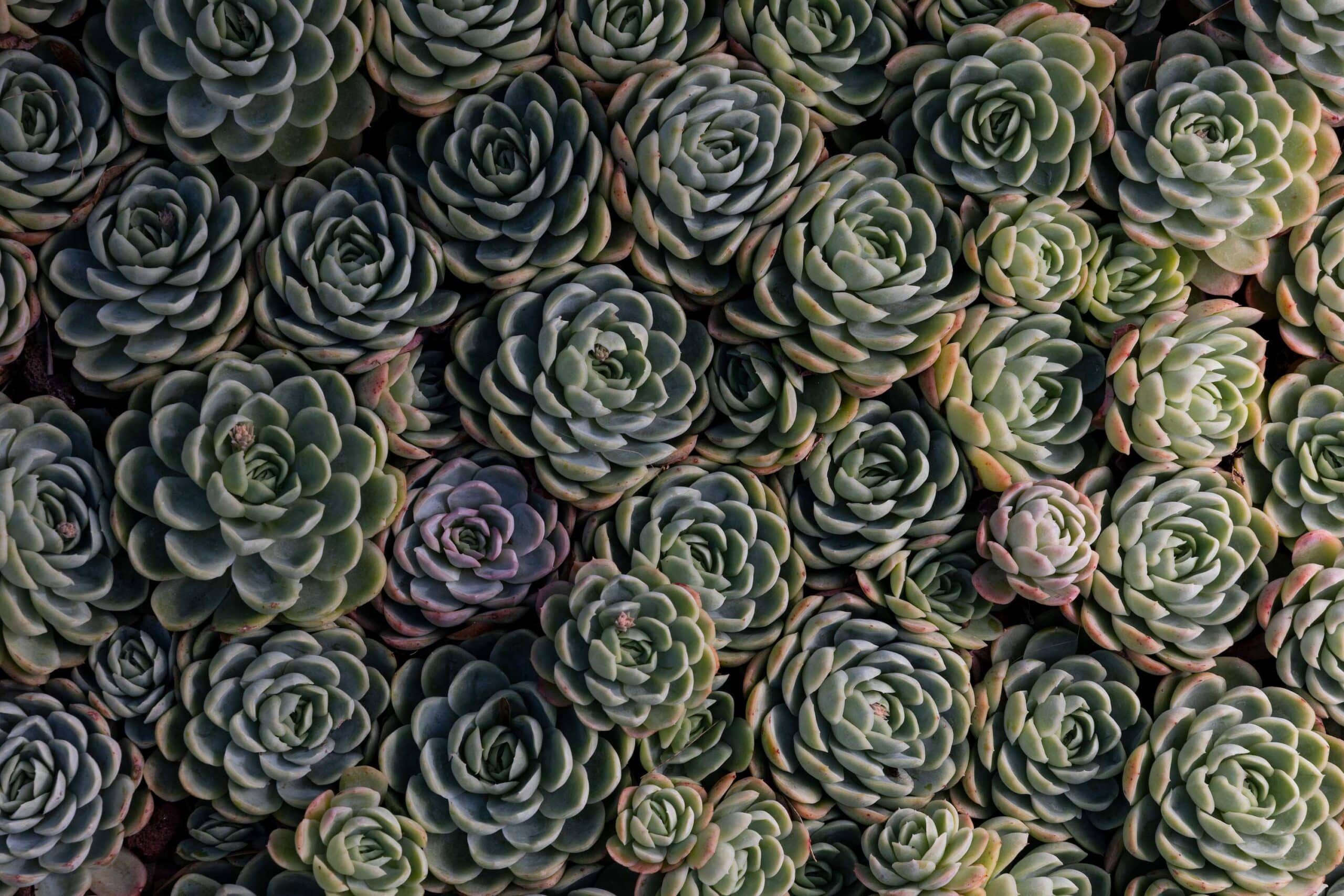
Plant Highlights
Plant Highlights
-
Quesnelia testudo
Highlight Month:
December
Nativity:
Brazil
Growth Habit:
Rosettes of stiff leaves normally grow attached to tree branches, but may also grow on the ground. The leaves overlap tightly to hold rainwater in the center.
Growing Requirements:
Partial shade, consistent watering.
Features:
Leaves are coated with white hairs on the underside. Flower stalks appear in cool months and hold many dark purple tubular flowers surrounded by hot pink bracts.
Where at Lotusland:
Upper and Lower Bromeliad Gardens
-
Sedum rubrotinctum ‘Aurora’
pink jelly bean plant
Highlight Month:
December
Nativity:
Mexico
Growth Habit:
Trailing stems covered with plump jelly bean shaped leaves form a succulent groundcover.
Growing Requirements:
Full to partial sun.
Features:
This is a pastel version of the well-known jelly bean plant. Pale green shades to pink, especially when stressed from drought or cold. It is easy to propagate from stem cuttings or rooting each bean-shaped leaf.
Where at Lotusland:
Succulent Garden
-
Aeonium arboreum ‘Zwartkop’
Highlight Month:
July
Nativity:
Canary Islands
Growth Habit:
Sturdy succulent stems may reach 3 feet or more and are topped with a rosette of dark burgundy leaves. In full sun, the plant looks nearly black. With time, the plants will branch and become loosely shrubby.
Growing Requirements:
Full to partial sun and well-drained soil. Very drought tolerant.
Features:
Selection of Aeonium arboreum is grown for its striking foliage. As each rosette matures, it produces a cone-shaped inflorescence of many tiny yellow flowers.
Where at Lotusland:
Succulent Garden, Main House steps, and Dracaena Circle
-
Caryota urens
fishtail palm
Highlight Month:
December
Nativity:
SW. & S. India, Sri Lanka
Growth Habit:
This fishtail palm is solitary, meaning it forms just one trunk. It grows up to 75 feet or more. When it reaches its mature height, it begins to flower. A large, branched inflorescence is formed in succession at each leaf node starting at the apex and progressing down the trunk. The process takes many years, but when it is over, the tree dies.
Growing Requirements:
Palms require even moisture and this species thrives in shade to partial sun. Cold hardy to perhaps 22° F.
Features:
The fishtail palm is aptly named in reference to the shape of the leaflets.
Where at Lotusland:
Fern Garden, behind the Dracaena Circle
-
Brachychiton acerifolius
flame tree
Highlight Month:
June
Nativity:
Eastern Australia
Growth Habit:
A tree to 60 feet tall and 30 feet wide.
Growing Requirements:
Full sun, needs little to moderate water once established. Grows best in well-drained soil.
Features:
B. acerifolius has unusual deeply-lobed foliage, which goes deciduous for a time in late winter, and a swollen, bottle-shaped trunk. Its most striking feature is a spectacular display of bright red flowers in late spring/early summer. The flowers are followed by large brown fruits which may hang on the tree for months.
Where at Lotusland:
B. acerifolius are planted in the Australian Garden, the area around the Visitors’ Center.
-
Dracaena draco
dragon tree, dragon’s blood tree
Highlight Month:
June
Nativity:
Canary Islands, Madeira Island and the Cape Verde Islands
Growth Habit:
A very slow growing tree. The plant may take up to ten or fifteen years to flower, at which point it will branch for the first time. It will eventually form a large multi-stemmed tree up to 20 feet tall and wide.
Growing Requirements:
Dracaena are succulent plants, and will grow in full sun or light shade, with moderate water, preferably in well-drained soil. They need a climate where winters stay mainly above freezing, as the leaves are frost-sensitive and the plants die at around 25 degrees. They grow well on the coast.
Features:
The leaves are sword-shaped and have a sharp tip. Small, creamy-white flowers are borne in branched spikes. The small, round fruit are fleshy and bright orange. Old specimens have scaly brown bark. The name “dragon’s blood tree” comes from the plant’s red sap, which was used in ancient Egypt as part of the embalming process and has been used in making paint and varnishes.
Where at Lotusland:
Over 60 Dracaena draco are planted in front of the Main House, the largest specimen in the middle dating back to Ralph Kinton Stevens’ ownership of the property when the area was his demonstration nursery. The remaning D. draco were added by Madame Ganna Walska to create a mass planting.
-
Bowiea volubilis
climbing onion
Highlight Month:
June
Nativity:
Uganda to South Africa
Growth Habit:
These true bulbs produce scrambling, photosynthetic inflorescences (up to 15′ long) that emerge from succulent bulb scales. The inflorescences can be trained to grow upward with support or they will spread along the ground. They are summer growers.
Growing Requirements:
Grows best in sun to partial shade in well-drained soil. The plant should be watered very little during its deciduous dormant season. Begin regular watering when new stems start to grow from the top of the bulb. This plant is not frost-tolerant.
Features:
Bowiea is a monotypic genus represented by one species, Bowiea volubilis, with two subspecies, ssp. volubilis and ssp. gariepensis. Subspecies B. volubilis ssp. gariepensis is a winter grower with larger flowers and is found in Namibia to the Northwestern Cape Province. All parts of the plant are poisonous but are used in traditional medicine in Africa.
Where at Lotusland:
Succulent Garden
-
Rosa ‘WEKpaltlez’ HOT COCOA
Hot Cocoa floribunda rose
Highlight Month:
June
Nativity:
Garden Origin
Growth Habit:
Compact shrubs to 3 feet with glossy green leaves.
Growing Requirements:
Full sun and regular water. Mulch to maintain even moisture. Prune in dormant season as for any rose. Deadhead regularly to encourage more blooms.
Features:
This floribunda rose was an All-American Rose Selection in 2003. Smoky orange blossoms tinged with purple as they age are showy and unique.
Where at Lotusland:
Rose Garden
-
Aechmea nudicaulis var. cuspidata (variegated)
Highlight Month:
June
Nativity:
Brazil
Growth Habit:
The vase-like rosette of leaves of this bromeliad is pale yellow striped with apple green and have black spines along the margins. The bright red-bracted flower spikes produce lemon yellow flowers in summer. While the original plant will die after flowering, it will produce several offsets that may be removed and replanted. It is usually epiphytic in its native range, but adapts well to containers or raised beds outdoors.
Growing Requirements:
Grow Aechmea nudicaulis var. cuspidata in bright shade either in a pot or in the ground with lots or organic material incorporated into the soil mix. Soil may be allowed to dry out between waterings, but maintain the central cup – made by the tightly overlapping leaves – full of water at all times. Fertilize every month or two with half-strength liquid fertilizer in the central cup.
Features:
The colorful flower spikes and brightly variegated leaves make this one of the most handsome bromeliads to grow.
Where at Lotusland:
Upper Bromeliad Garden at the edge of the Main Lawn.
-
Pseudobombax ellipticum
shaving brush tree
Highlight Month:
June
Nativity:
Mexico to Guatemala
Growth Habit:
This is a small tree – to 20 feet in cultivation with thick stems and sometimes even forming a swollen base or caudex. It is deciduous in winter and flowers before the large, green leaves are produced in early summer.
Growing Requirements:
Somewhat tolerant of light frosts, the shaving brush tree does best in subtropical or tropical zones. It can be grown as a potted specimen where it will be more likely to form a caudex.
Features:
The large – 4 inches or more – flowers have sturdy greenish brown sepals that curl below the showy cluster of many stamens. There are both pink and white forms.
Where at Lotusland:
Cycad Garden


